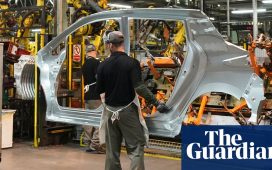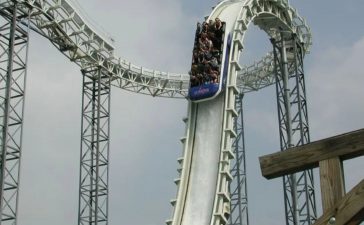Though they get little respect from the industry’s old guard, technologist Martin Roschiesen’s lab grown diamonds will soon flood the $85 billion fine jewelry market. They could also play a critical role in providing advanced chips for things like electric vehicles and quantum computing.
Inside his rehabbed warehouse in South San Francisco with its line of glowing plasma reactors the size of minivans, Martin Roscheisen, CEO and cofounder of Diamond Foundry, unveils a 4-inch single-crystal diamond wafer. He says it was cut from a palm-sized 423-carat rough stone, the biggest man-made diamond ever, large enough to fashion a set of crown jewels. But Roscheisen, 52, presents it as a preview of the age of quantum computing. “Every chip in the future will use diamond wafers,” he says. Be it for phones, laptops, cars, diamond will enable ever smaller high-energy electronics.
Because the path to making diamond semiconductors passes through an expertise in forging gem-quality stones, Roscheisen sees it as a foregone conclusion that his industry will soon dominate the $85 billion diamond jewelry market. He says Diamond Foundry has tripled diamond output in the past year to five million carats, and intends to hit 20 million per year in 2025 when his $800 million solar-powered diamond factory in Spain is up and running. At that volume he’ll be producing about 60% as many stones as giant De Beers Group, which mined 35 million carats last year, mostly from Botswana at a much higher cost.
“The consumers are really getting screwed here. You’ll know in a year or so. I’ll bury you with synthetic diamonds in the end.”
We’re not talking cubic zirconia or moissanite here. Man-made diamonds are not new; in the 1950s General Electric forged the first specks by mimicking the high temperatures and pressures deep in the Earth’s crust. Today billions of carats of man made diamonds are used for industrial applications but it’s taken decades to advance the technology to yield jewelry quality diamonds in sizes almost unobtainable in nature and indistinguishable from natural stones unless you have a fluorescence spectroscopy machine. From nothing a decade ago, lab-growns now make up 10% of the 125 million carat annual diamond jewelry trade, at prices often 80% less than natural diamonds. “Our average customer has found it difficult getting into mined diamonds from a financial standpoint,” says Pandora CEO Alexander Lacik, who started selling lab diamonds in 7,000 stores last year. “We’re not taking market share. We’re creating more market.”
Roscheisen, at his South San Francisco lab, promises 8-inch diameter single-crystal diamond wafers within two years.
Cody Pickens for Forbes
While mall jewelers are enjoying great margins selling three-carat flawless lab-grown diamond engagement rings for under $4,500 (vs more than 10 times that amount at Tiffany & Co), luxury houses like Cartier and Van Cleef & Arpels turn up their noses. Snorts Edward Asscher, president of the World Diamond Council. “For the larger sizes they are so cheap that they have lost all real value.”
“I have the largest diamond trading network, and I won’t move synthetics, they lack scarcity so they lack value retention,” says New York diamond legend Martin Rapaport, whose RapNet lists more than one million diamonds for sale. “The consumers are really getting screwed here. You’ll know in a year or so. I’ll bury you with synthetic diamonds in the end.”
Roscheisen thinks it’s he who will be doing the burying. It’s like how Mikimoto popularized cultured pearls, he says. “It started with Jackie Kennedy not wanting to pay up for ‘natural’ pearls in favor of those that are cultured. You can still find all-natural pearls at outlandish prices, but they’re only 1% of the market.”
In the same way environmentally conscious consumers are driving exponential growth in the market for plant-based foods, Diamond Foundry, whose tagline reads, “Diamonds. Evolved,” is betting that it can capture a new generation of jewelry buyers. Mined diamonds have a carbon dioxide footprint of about 170 kg per carat, versus 8 kg or less for lab-grown. Diamond Foundry aims to be zero-carbon. The reactors in Roscheisen’s converted apple warehouse in Wenatchee, Washington run on hydropower from the Columbia River. The $850 million factory under construction in Extremadura, Spain will use 30 megawatts of solar.
Says Roscheisen,“We plan to replace all of diamond mining in five years.”
Fresh from the plasma reactor, rough diamonds made by Israel-based Lusix, which provides stones for Tag Heuer watches.
Lusix
Born and raised in Munich, Germany, serial entrepreneur Roscheisen earned his PhD in engineering at Stanford in the late 1990s just as Wall Street’s interest in the world wide web was exploding. In 1995 Roscheisen co-founded online legal library FindLaw ,which was sold to Thomson Reuters; in 1998, he co-founded email listserv Egroups, which he sold to Yahoo! for $450 million. After the dotcom bubble burst, in 2002 he co founded solar panel maker Nanosolar, which raised $600 million but couldn’t advance its printed thin-film copper indium gallium selenide solar panel technology fast enough to outlast Chinese solar competitors and went bankrupt.
Investor James Joaquin of Obvious Ventures recalls an early conversation with Roscheisen, who explained his team at Nanosolar had become adept at manipulating single atoms — they had just picked the wrong atom. “For their next act they would do it with carbon atoms,” says Joaquin, who is looking forward to the advent of smartphones with unbreakable diamond screens.
“Roscheisen could see a path to this before it was obvious to others,” says Joaquin. Roscheisen’s Diamond Foundry was launched in 2015 with $315 million in funding and an impressive list of backers led by Andy Bechtolsheim, founder of Sun Microsystems, Tony Fadel, creator of the first iPhone, and Twitter co-founder Evan Williams. For star power they dealt in Leonardo DiCaprio, who directed and starred in 2006’s Blood Diamond.
In 2021, Fidelity Investments stepped in with $200 million more equity, at a $1.8 billion valuation. According to SEC filings, Fidelity portfolio managers have marked up the value of their Diamond Foundry convertible preferreds by 35% since then — implying an equity value to the company of $2.4 billion. Forbes estimates revenues of roughly $700 million this year. Roscheisen owns 25%.
In order to produce its new 423 carat wafer, ideal for the next evolution of microchips, Diamond Foundry has tapped into the know-how of German company Audiatec, which it acquired late last year. Their breakthrough is in an area called diamond heteroepitaxy — growing crystals layer by layer from the atomic level. They’ve figured out how to place 10 single atoms of crystallized carbon on a base of iridium, coax them to grow in identical dimensions and merge into a “mother” base of a single-crystal diamond sheet. “Otherwise it is like multiple people tiling a floor from different ends without a template — they’d meet in the middle without the tiles fitting together,” explains Roscheisen. The magic happens over several weeks in a 3,000-degree plasma reactor, injected with methane and blasted with microwaves which cause layer upon layer of pure carbon atoms to fuse onto the growing diamond crystal. Diamond Foundry’s competitive moat: it took its researchers 25 years and thousands of experiments to get it right.
By mid 2025 Roscheisen expects to be producing 20 million carats per year, then on to 50 million, with rough stones up to 8 inches in size. You’ve got to make it up on volume when the product you make keeps getting cheaper. Over the past five years the average stone sold at Diamond Foundry’s retail subsidiary Vrai has grown in size from 1.3 carats to 1.95 carats today, while falling in price from $3,600 to $2,500 per carat. Most of Vrai’s sales are done online–a classic two carat solitaire round engagement ring on an 18k gold band sells for $3,300–though it has showrooms in 11 major cities around the world including New York, London and Shanghai.
“It was small, dirty, of horrific quality and color — but it was a diamond. I gave that diamond to my wife and she wears it to this day.”
Benny Landa spun out diamond-maker Lusix from his Rehovot-based Landa Labs. The digital printing pioneer is said to be Israel’s most prolific inventor.
Lusix
Competitors include De Beers’s lab-grown division Lightbox, which since 2018 has attempted to bifurcate the market by selling at a set $800 per carat no matter the cut or clarity.
Another, called WD Lab Grown Diamonds, in Beltsville, Maryland, sells both to middle market jewelers, like Robbins Brothers and Helzberg, as well as to a new generation of lab-only luxury brands like Oscar Massin, named after a legendary French jeweler to royalty, launched in 2021 by the former CEO of Cartier. One design incorporates 3.76 carats of diamonds on a $21,500 ring. “It’s a leveling up,” says Brittany Lewis, chief marketing officer at WD. Women are buying their own diamond jewelry, and may like the idea that in doing so they are underwriting environmentally conscious nerds inventing new semiconductors, she says. “This is not just a symbol of a transactional relationship.”
Despite the traditional jeweler’s jaundiced view of lab grown diamonds, the field continues to attract blue blood brands. Israeli entrepreneur and inventor Benny Landa, 76, operates a dozen plasma reactors at Lusix, in Rehovot, Israel. His company got a big reputational bump last year with a $90 million equity investment led by LVMH Luxury Ventures. Already, LVMH’s Tag Heuer group has fashioned 40 Lusix stones into its $400,000 Carrera Plasma watch. Landa appeared on the 1995 Forbes list of the World’s Richest before selling his Indigo Digital Printing company to HP for an inflation-adjusted $1.4 billion. He has opened a second factory in Israel, but rejects the notion that lab diamonds are not natural. “All we do is provide the conditions to enable nature to do the growing, allowing the carbon atoms to self-assemble into diamond crystals. Just as with earth-grown diamonds, each diamond is unique. No two diamonds have the exact same shape or characteristics — as in all of nature.”
“The big trouble is when you can no longer tell the difference,” laughs Cormac Kinney, CEO and founder of Diamond Standard. For now, jewelers rely on fluorescence spectroscopy machines to detect lab-grown diamonds. While people remain willing to pay multiples more for mined stones, Kinney has figured out a way to commoditize them — and prop up prices in the process. Diamond Standard is attempting to create a tradable market similar to gold coins and bullion, only for diamonds. The company nestles eight or nine diamonds with a total weight of about 3 carats into a small round plastic case resembling a coin. Embedded in the case is a computer chip that identifies it and can connect to a blockchain. To ensure fungible trading on CFTC-regulated exchanges Kinney’s Deloitte-audited recipe ensures that diamonds from coin to coin share equivalent attributes. Current price for his diamond coin is $5,400. He’s so far sold nearly $250 million worth, and has big hopes for futures trading on the CME followed by an ETF.
Diamond Standard charges a steep handling fee of 3.5% of the value of the stones it moves. It’s one reason why he only uses more expensive naturally mined diamonds in his coins and bars. Says Kinney, of lab grown diamonds, “They may be wonderful, but they are not natural and not scarce.”
Roscheisen for his part, cares little about the diamond industry’s snobblery. He insists that a version of Moore’s Law will ultimately apply to the diamond market and believes that in 10 years diamond will instead be quoted the way silicon semiconductors are today — in dollars per square inch and sold by the wafer. In fact, for his next reveal, the company is using diamond chips to engineer an electric vehicle power module one-sixth the size of Tesla’s smallest.
“This next level of miniaturization with diamonds is right around the corner.” Coming from a man set to churn out millions of carats, he’d better hope so.











